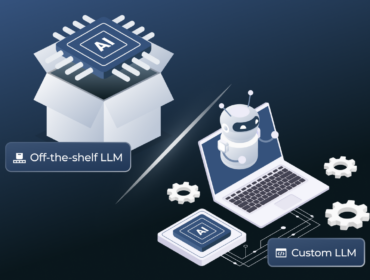There has been a lot of buzz lately around digitalization and its adoption into SMEs. Many think it’s a new magic pill for a business to continue working and earn a profit. According to IDC investments into digital transformation will increase to $1.7 trillion worldwide by the end of 2019.
According to research conducted by Bain & Company, the revenues of companies considered to be leaders in digitalization in 2017 had grown twice as fast as those of businesses that failed to implement this.
But what does digital transformation really mean for businesses? How can you approach it the right way for small and medium business?
What are the most common traps businesses fall into? Should we focus on implementing cloud technology, invest in hardware, or any other options? Digitalization of your business is a decision with a high ROI. Let’s dive deeper and see all the options and make the choice most suitable for you.
What does digital transformation mean for businesses?
First, it’s important to define the main stages for digital business transformation; we’ve settled on the following crucial ones:
- Harnessing machine intelligence to speed up daily processes and increase the operation pace. For instance, companies can improve conversion rates and customer satisfaction by implementing automated client on-boarding. Where a business would normally assign an employee to track down a customer’s progress on the lead funnel, they will now be able to outsource the same range of tasks to a third-party CRM solution. Hiring can be automated as well – instead of hiring a writer to work on a job description, manually shortlisting candidates, and conducting interviews, a business manager can use AI for resume scanning and generating job descriptions. Finally, intelligent ERP apps will allow enterprises to plan business models, manage accounting, and run key business processes – all in one suite of tools.
- Dividing monolithic teams into smaller dedicated departments. The defining factor of digital transformation is agility. When there’s a need to implement changes in products, it’s easier to do this by splitting the company’s workforce into the teams of manageable sizes (5-8 people). Redefining the approach to teamwork and splitting employees into dedicated units will help each person on the team get a better understanding of their responsibilities.
- Adding transparency to the business. There are several reasons why this matters so much. Transparency breeds trust within a team makes teamwork more efficient since everyone involved has the same information. This leads to open and sincere feedback from the team that can be used by a manager to improve the workflow. Getting started with transparency doesn’t take much — it’s enough to regularly update employees on the state of the company, provide shareable access to all the documentation, and be open to question and criticism.
To digitalize or not to digitalize: time to choose
Needless to say, the digital business transformation is a long-term investment. It takes months to pay off and is quite expensive to implement. So why are businesses still upgrading their operations and products and building a whole new infrastructure to stay in line with the new trend? Here’s a brief overview of all the advantages digital transformation provide businesses with.
- Improving employee satisfaction. Increasing the level of talent retention is the goal most companies want to achieve. With digital transformation, companies can benefit from remote work, automating mundane tasks to use employees for more challenging tasks, telecommunication within international offices, etc. All of the above will motivate team members to stay onboard and keep evolving at the same pace as the company does.
- Increased cost savings by implementing paperless operations. According to StatisticBrain, 45% of all the paper documents printed at the office, end up in trash cans — that’s a fair share of the wasted budget. That’s where digital transformation comes in handy, with paperless invoices, cloud-stored document copies, tax e-filing, etc.
- Collecting customer insights. Digitalization can be visible not only within the company but on the outside as well. Using business intelligence tools and analyzing collected data helps to understand the consumer better. A small business can use digital transformation to map out a customer’s journey, get a better idea of the range of products a shopper is likely to buy, find out which time of day is better to reach out to a client, etc.
- Improves collaboration within the team. Thanks to the growing number of vendors offering collaboration apps, companies can leverage the power of digital transformation within the workplace. Using technology allows project managers to get immediate feedback from employees and leads to faster problem-solving and decision-making. Companies that have already started using collaborative tools say the workflow has improved for the better. Autodesk, for instance, joined the Slack community in 2015 — it was said to “transform the company’s organizational culture”. For McCorvey Sheet Metal Works, a Texas-based manufacturer, using Trello has been a transformational experience – the company managed to eliminate the distribution of paper-based documentation saving over $70,000 per year. With all that in mind, it’s clear that digital transformation has enough potential to help companies redesign the way they make decisions and build communication within the team.
- Increases business agility. Being able to adjust processes, adapt to the market, and iterate on their internal processes is crucial for companies in order to stay afloat during the periods of technological and economic change. Digital transformation provides all the opportunities to achieve such agility — it creates faster feedback loops, allows companies to constantly assess risks and re-evaluate current goals based on real-time insights. Cloud-based technologies and automation allow brands to provide continuous delivery of new products and services as well as speed up the communication within the team.
Digital business transformation examples
Big and small business automation is revolutionizing all industries, not just the companies producing tech solutions directly. There are a ton of examples of how businesses across different fields use digital transformation — here are a few.
1. Supply chain
As of now, the logistics industry is not among the early adopters of digital transformation. According to a recent McKinsey study, compared to four other industries (marketing and distribution, product and services, processes, ecosystems), the supply chain has the lowest level of digital transformation adoption. Still, there are trends and tendencies that are already dominating the market:
- Machine-learning systems. Thanks to predictive learning technologies, supply chain management can be improved with recommendations on how to deal with bottlenecks.
- Supply chain small business automation. To avoid pitfalls and increase the efficiency of employees and help them focus on meaningful tasks. For instance, supply chain managers can automate data gathering, scrubbing, and entering.
- Detailed customer updates. By offering customers transparency with track-and-trace systems, supply chain managers can enable detailed end-to-end customer management.
Case study:
Li & Fung LTD — a global supply manager — has started digitizing its global supply chains in 2017. Up to 2019, the company focused on transferring most daily processes to digital. The list included:
- Digitizing paper processes;
- Creating a platform in order to connect customers to the global vendor base;
- Creating a system for online billing and payment;
- Improving the tech expertise of a company’s employees;
- Developing a system for data-sharing that allows teams to quickly take collective decisions.
According to the white paper on Li & Fung’s case, after investing in digitization, a company managed to cut operation costs and time. Implementing technological solutions has allowed the brand to see new ways of capturing value for customers. Li & Fung is now capable of quickly leveraging data to correlate its products with those that competitors offer and provide customers with valuable insights.
2. Retail
The expectations of a modern shopper increase on a daily basis — that’s why retail has to be responsive to digital transformation like no other industry. By far, it’s one of the frontrunners and the early adopters of technological advancements.
- Blurring the borders between digital and in-store experiences. The main goal of modern retailers is to make the omnichannel shopper (the one that interacts with a digital and physical store to a similar extent) comfortable — that’s where IoT, VR/AR, and AI are highly sought after.
- Data-driven marketing. Using business intelligence software to collect and analyze customer data is another major trend in retail brought by digital transformation. It allows business owners to avoid human bias they could’ve seen during surveys — shoppers, on the other hand, can get more comfortable experiences in a seamless way.
- Cutting costs with automation. It tackles customer service, delivery, and other mundane tasks. AI can allow companies to reduce the number of employees or improve the productivity of each member of the team. These things are especially important when it comes to small business automation. Moreover, technological automation can speed up internal processes such as filling the paperwork, allowing the team to focus on the tasks that require creativity and human intelligence.
3. Automotive industry
Automotive brands like Toyota, BMW, in cooperation with Volkswagen, and Tesla are the main drivers of technological innovations, with their own research centers and labs. The contribution of digital transformation to the automotive industry is tremendous — let’s take a look at a few ways a trend has disrupted the field.
- Autonomous vehicles (AV). The AV industry still has enormous potential. With big players like Apple, Tesla, and Google all working on AV technology, we can expect to see the first effects of self-driving vehicles as soon as the next decade. This would mean the reduction of the workforce needed for driving, increased speed of movement, and a decrease in casualties.
- Digital marketplaces for automotive industries. Digital transformation gives buyers a possibility to connect with sellers, insurers, transporters, and so on. At Unicsoft, we have experience in creating an online marketplace that allows car owners to connect with car inspectors, fill in forms that used to be printed on paper, make damage claims, etc. This has given iOS users access to all the major players of the automotive industry, which are normally dispersed and hard to contact, through a single application. The amount of time car owners are capable of saving thanks to such marketplaces is enormous – it’s a relatively cheap yet efficient way to implement digital transformation.
- Development of mobility as a service. Uber and Lyft are not the only ones to come up with car-sharing apps. In fact, some of the big car manufacturers are entering the field as well — Fiat is now collaborating with Google on its app for shared rides, while Volkswagen has already released an app of their own.
- According to an Accenture report, the automotive industry is the second data-driven industry in the world (after utilities). However, recent events like the General Motors cyber-attack prove that the field is in need of a solid security system. The next step in digital transformation is finding data protection advancements.
- Digitizing the manufacturing process. Data gathering and analytical tools will speed up the process of component design, manufacture, and end-to-end delivery. Thanks to cloud-based tools, all parties involved in production will have shared access to data. This improves the production agility and stability.
- 3D printing. Brands like Audi have already launched their own 3D printing centers. The technology helps manufacturers produce spare parts. For cars like Rolls-Royce that take 4-7 month to produce, the introduction of 3D printing increases the pace of production significantly. Moreover, the Hackrod’s case (a startup that crowdfunded over $300,000 in order to create a platform for vehicle and motorcycle customization based on 3D printing) proves that digital transformation can improve and personalize the customer experience itself allowing the manufacturer’s sales to skyrocket.
4. Energy and utilities
In a rapidly changing market, the utility industry was the first to turn to digital transformation. Facing tight competition, regulatory constraints, and macro-political challenges, the energy industry is already actively using the following technological advancements:
- IoT. Using innovations like smart grids or smart meters, the industry benefits from the Internet of Things. According to Gartner, the number of IoT devices will reach 20.4 billion by 2020.
- Predictive analytics. In order to forecast and prevent discrepancies (those found in determining the amount of energy use, for instance) from happening, utility business managers are using machine learning technologies like predictive analytics.
- Big data. The role of gathering and processing data in the utility industry is crucial, seeing that it allows companies to find places with high energy storage and shift the focus of the industry from the product- to consumer-facing. Instead of developing a line of products and testing it for various audiences, brands will now be able to build tools with customers’ preferences in mind. Needless to say, it will decrease the amount of time needed to deliver a new product to the market (no need for extensive idea testing) as well as increase the odds of a product’s success after the launch.
Conclusion
For a successful digital transformation, these important aspects should be in balance: people, processes, technology. It takes time to choose those most suitable for your technological needs.
Sometimes it’s even cheaper and more convenient to create a custom solution, which perfectly matches your processes. It will take some time to integrate and tech people to use new technology.
Done responsibly, however, it can be quite enjoyable as a process and can produce its first positive effects within a few months after integration.
If you are looking for more information regarding the subject or want to know how we can help boost your project, email us or simply drop us a line. We would be happy to assist your business needs!






